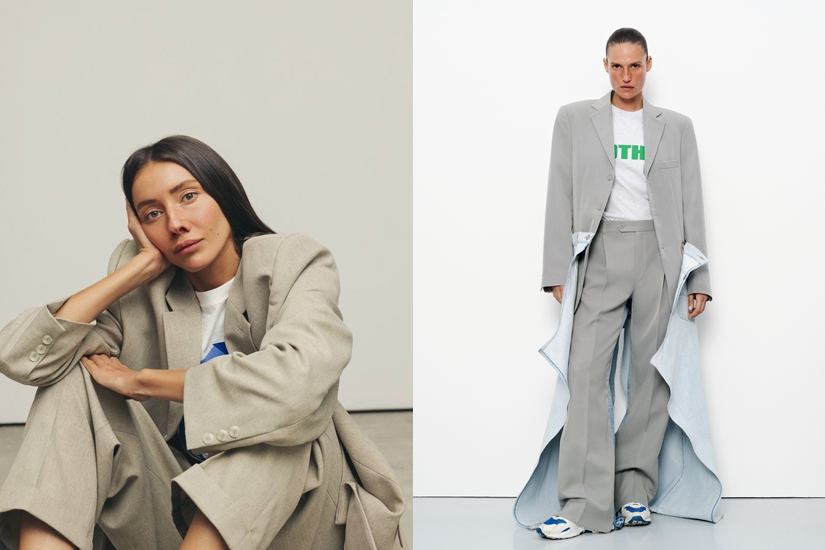Once the fashion director of Vogue Ukraine, Julie Pelipas, the mastermind behind the Ukrainian brand BETTTER, is a familiar figure in the street style of fashion weeks. With her tall stature, you won’t find major brands in her outfits; instead, she often wears the same pieces repeatedly and enjoys mixing vintage and second-hand clothing. Everyone can definitely learn from her styling how to create an intellectual look with minimalistic methods.

But Julie Pelipas is not content to just be a fashion director. Throughout her career, she has recognized that today’s clothing market is rife with issues of excessive waste. To put it simply, the fast fashion supply chain that dominates the world is associated with widespread industrial pollution during its production processes. Given this context, Julie Pelipas believes that the only thing that can bring about change is creation; upgrading and transforming technology is the most crucial factor for a sustainable society.

After that, Pelipas made a significant decision. The fashion brand BETTTER, which she founded in 2020, has quickly become an important name in the fashion industry in just four years. She advocates for Upcycled System technology rather than excessive production, and the reason behind this is simple: it’s purely for the sustainable development of our planet. The brand makes good use of recycled materials, and each BETTTER garment embodies both style and substance, accompanied by a “Care Passport” that details the source of the fabric.


Recently, Julie Pelipas attended the Lane Crawford Spring OPEN HOUSE in Hong Kong. This event focused on emerging designers and innovative brands, showcasing a commitment to sustainable design and exceptional quality, and she personally engaged in a conversation about eco-fashion with ZTYLEZ.
Z: What is the vision behind BETTTER? What inspired you to create an upcycling fashion brand?
J: Everyone involved in our industry occasionally feels that “this industry is collapsing, and we have gone too far.” The concept of BETTTER was something I came up with during my time at VOGUE. Entering this industry through the media portal allows you to have a full understanding of the “good and bad” aspects. The fashion industry operates in this way: adhering to outdated supply/production system models, resulting in excess inventory, with no solutions for the potential next life cycle of these garments. Then we have those ugly stories that no one wants to talk about, where clothes are burned, discarded, or (in the best-case scenario) left forever in the unsold. I admire many recycling startups; recycling is a form of downcycling, which is the exact opposite of upcycling. But we can do it more sustainably and intelligently. And surprisingly, there are still not many participants in this field. Upcycling as a method has been greatly marginalized: seen as some form of art/patchwork unrelated to technology and long-term sustainable development. Thus, it has not been invested in, explored, or believed in.

Z: What is the design process of BETTTER like?
J: At BETTTER, we work with a focus on redesign, starting with an analysis of slow-moving inventory, followed by the implementation of automation through proprietary software. When we collaborate with brands, the first step in the creative process is a thorough study of the brand’s heritage and history, ensuring that as we redesign garments, the core DNA is preserved and respectfully reinterpreted. This material-first approach guarantees that each piece of clothing is unique and makes the most of available resources. In contrast, traditional design often begins with a concept or trend, then seeks new materials to realize that vision. Our process upends this model, emphasizing creativity within the constraints of existing materials.

Z: Due to the uniqueness of available materials, upcycling is often viewed as a small-scale process for producing one-of-a-kind garments, but BETTTER offers various sizes that make upcycled fashion more commercial. How does BETTTER successfully scale up the upcycling process?
J: This is a niche practice that leans towards a style closer to haute couture, but there is a severe lack of data regarding unsold inventory materials. In some cases, you might mistakenly associate upcycling with vintage or second-hand clothing reproduction. The depth of unsold inventory for each SKU can be nearly as extensive as that of full-size stock. The nature and scale of unsold inventory always vary, which is why we place such emphasis on the technology behind the products. It’s a classic chicken-or-egg scenario—without technology, such products cannot be scaled up, but without products, technology cannot be developed. Therefore, we do both. This model not only makes upcycled fashion commercially viable, but also sets a precedent for other brands, proving that sustainability and scalability can coexist.

Z: What are your thoughts on the future of Sustainable Fashion?
J: In fact, there aren’t any specialized upcycling programs currently available. We need to pass on this knowledge, data, and tools to aspiring designers. I hope to promote this new way of thinking and focus on utilizing existing materials rather than creating new ones. BETTTER contributes to the future by continuing to push the boundaries of upcycling technology, partnering with other sustainable brands, and advocating for systemic change in the industry.


